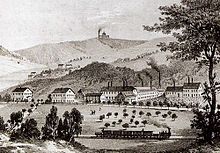Albertsbahn AG
The Albert Bahn AG was founded in 1853 railways in Saxony . The company was the owner and operator of the Dresden – Tharandt railway line and a few subsequent branch lines to the hard coal pits in the Döhlen basin . The most important of the branch lines - the Hänichener coal railway - has become known nationwide as the “Saxon Semmering Railway” because of its difficult route.
history
Around 1850 , the coal mines in Plauenschen Grund had to struggle with increasing competition from English coal and the competitive advantage of coal from the Zwickau district , which since the completion of the Saxon-Bavarian State Railway and the Leipzig connecting railway could be delivered inexpensively by rail to traditional sales areas. It was the aim of the directors of the Hänichen coal mining association Emil Becker and Otto Schneider to counteract this by building their own railway line through the Plauenschen Grund to Tharandt . A corresponding request was then discussed by the Saxon state parliament in 1851/52 and a license was granted by the government. However, this was combined with the requirement to design the railway in such a way that it could be used as part of a possible Dresden-Freiberg railway. It should also be accessible to all hard coal mines located in Plauenschen Grund. The car manufacturing company Schrumpf in Dresden, the ironworks of Baron von Burgk , the chemical factory Reichard and the mechanical engineering company Petzold in Potschappel , the boiler factory Lattermann in Zauckerode , the pottery factory Knieling, the cement factory Michael in Döhlen , the paper factory Thode as well as expressed interest in a connection the Römer dye works in Hainsberg . Saxony secured a right of first refusal, but was not prepared to participate financially in the construction of the railway line by resolution of the meeting of the estates on May 21, 1852. Nevertheless, they were confident that the estimated construction costs of 1,700,000 thalers would be covered by the great interest in the shares .
On June 14, 1853, the Albertsbahn AG was founded in Dresden and its statutes were approved by 1168 votes against 62. Since July 23, 1853, the chief engineer and railway pioneer Guido Brescius was in charge of the construction of the Albertsbahn . The first groundbreaking for the construction of the railway, which was allowed to bear his name with the permission of Crown Prince Albert of Saxony , took place on September 12, 1853.
The 14 km long main line was opened on June 28, 1855. It was designed as a single track but the substructure was intended for two tracks. From it, other freight railways with a length of almost 25 km branched off to the neighboring mines and loading areas, the design of which has been corrected several times compared to the original plan:
- Elbezweigbahn in Dresden (April 2, 1856)
- Deuben Coal Railway (April 2, 1856)
- Niederhermsdorf coal branch line (December 1, 1856)
- Hänichener Kohlenzweig Railway (April 1, 1857)
The Rippiener or Hänichener coal railway (called Windbergbahn ) is the most famous branch railway. It leads from Birkigt (today part of Freital ) to Hänichen (today part of Bannewitz ) and was put into operation on April 1, 1857 for freight traffic and finally on December 21, 1907 for passenger traffic. It is also known as the "Saxon Semmering Railway".
The importance of the main line, which had its starting point at the Albertbahnhof in Dresden, only increased when it was continued from Tharandt to Freiberg by the Saxon State Railways in 1862 . Today this line is part of the Dresden – Werdau railway line , and thus the Saxony-Franconia main line to Nuremberg .
The concession for the Albertsbahn was initially issued for 20 years until 1873. As a result of the German War in 1866, however, the Kingdom of Saxony sought to nationalize its railways. Albertsbahn AG did not oppose these plans, as the hoped-for rich profits for the shareholders had not materialized. On July 1, 1868, the Albertsbahn AG became the property of the Saxon state for 2,862,800 thalers . As compensation, the shareholders received a dividend for the remaining five years of the concession, which was calculated from the average profits of the past 15 years.
Locomotives and wagons

In 1853, four locomotives with three tenders, twelve passenger cars, four baggage cars and 300 freight cars were planned as operating resources.
For the main Dresden – Tharandt line, the Albertsbahn acquired three separate tender locomotives from Hartmann in Chemnitz in 1855. They were the first triple-coupled locomotives from this manufacturer and a Saxon railway at all. The locomotives were named GLÜCKAUF , HARTMANN and THARANDT . A fourth NEUE HOFFNUNG locomotive, largely identical in construction , was added in 1863.
In 1857 the Albertsbahn procured three small tank locomotives from the same manufacturer for the operation of the Hähnichener coal railway after the locomotive FRIEDRICH AUGUST from the Dresden manufacturer W. Bayer had proven to be unsuitable. With their leading bogie, they exhibited good archability. This enabled them to navigate the narrow radii of the factory tracks in the coal pits. The locomotives were named ELBE, WINDBERG and STEIGER . Two more locomotives with the names FREIBERG and BURGK followed in 1858 and 1886.
literature
- Eduard Gottwald: Description of the Alberts (Dresden-Tharandter) railway with its branch lines after the various coal works of the Weißeritz area in Free Gaben für Geist und Gemüth , Dresden / Leipzig 1853 ( digitized version )
- Gunther Hoyer: The Windbergbahn, the first German mountain railway. in: Messages from the Saxon Homeland Security Association . Issue 2/1992, pp. 29-33.
- Jürgen Schubert: The Windbergbahn . transpress VEB publishing house for transport, Berlin 1982, without ISBN.
- Jürgen Schubert: The Windbergbahn . Kenning Verlag, Nordhorn 1993, ISBN 3-927587-18-4 .
Web links
Individual evidence
- ↑ SCHUBERT 1982 p. 66f

